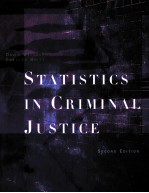图书介绍
Statistics in criminal justice2025|PDF|Epub|mobi|kindle电子书版本百度云盘下载

- Weisburd 著
- 出版社: Wadsworth;Thomson Learning
- ISBN:0534595081
- 出版时间:2003
- 标注页数:612页
- 文件大小:20MB
- 文件页数:626页
- 主题词:
PDF下载
下载说明
Statistics in criminal justicePDF格式电子书版下载
下载的文件为RAR压缩包。需要使用解压软件进行解压得到PDF格式图书。建议使用BT下载工具Free Download Manager进行下载,简称FDM(免费,没有广告,支持多平台)。本站资源全部打包为BT种子。所以需要使用专业的BT下载软件进行下载。如BitComet qBittorrent uTorrent等BT下载工具。迅雷目前由于本站不是热门资源。不推荐使用!后期资源热门了。安装了迅雷也可以迅雷进行下载!
(文件页数 要大于 标注页数,上中下等多册电子书除外)
注意:本站所有压缩包均有解压码: 点击下载压缩包解压工具
图书目录
chapter one1
Introduction: Statistics as a Research Tool1
The Purpose of Statistics Is to Clarify and Not Confuse3
Statistics Are Used to Solve Problems4
Basic Principles Apply Across Statistical Techniques5
The Uses of Statistics7
chapter two13
Measurement: The Basic Building Block of Research13
Science and Measurement: Classification as a First Step in Research14
Levels of Measurement15
Relating Interval, Ordinal, and Nominal Scales: The Importance of Collecting Data at the Highest Level Possible22
What Is a Good Measure?23
chapter three33
Representing and Displaying Data33
What Are Frequency Distributions and Histograms?34
Extending Histograms to Multiple Groups: Using Bar Charts40
Using Bar Charts with Nominal or Ordinal Data47
Pie Charts48
Time Series Data49
chapter four59
Describing the Typical Case: Measures of Central Tendency59
The Mode: Central Tendency in Nominal Scales60
The Median: Taking into Account Position62
The Mean: Adding Value to Position68
Statistics in Practice: Comparing the Median and the Mean76
chapter five86
How Typical Is the Typical Case?: Measuring Dispersion86
Measures of Dispersion for Nominal-and Ordinal-Level Data87
Measuring Dispersion in Interval Scales: The Range, Variance, and Standard Deviation94
chapter six115
The Logic of Statistical Inference: Making Statements About Populations from Sample Statistics115
The Dilemma: Making Statements About Populations from Sample Statistics116
The Research Hypothesis119
The Null Hypothesis121
Risks of Error in Hypothesis Testing123
Risks of Error and Statistical Levels of Significance125
Departing from Conventional Significance Criteria127
chapter seven135
Defining the Observed Significance Level of a Test:A Simple Example Using the Binomial Distribution135
The Fair Coin Toss137
DifferentWays of Getting Similar Results141
Solving More Complex Problems144
The Binomial Distribution145
Using the Binomial Distribution to Estimate the Observed Significance Level of a Test149
chapter eight159
Steps in a Statistical Test: Using the Binomial Distribution to Make Decisions About Hypotheses159
The Problem: The Impact of Problem-Oriented Policing on Disorderly Activity at Violent-Crime Hot Spots160
Assumptions: Laying the Foundations for Statistical Inference162
Selecting a Sampling Distribution168
Significance Level and Rejection Region170
The Test Statistic175
Making a Decision175
chapter nine184
Chi-Square: A Test Commonly Used for Nominal-Level Measures184
Testing Hypotheses Concerning the Roll of a Die185
Relating Two Nominal-Scale Measures in a Chi-Square Test193
Extending the Chi-Square Test to Multicategory Variables: The Example of Cell Allocations in Prison199
Extending the Chi-Square Test to a Relationship Between Two Ordinal Variables: Identification with Fathers and Delinquent Acts204
The Use of Chi-Square When Samples Are Small: A Final Note209
chapter ten219
The Normal Distribution and Its Application to Tests of Statistical Significance219
The Normal Frequency Distribution,or Normal Curve220
Applying Normal Sampling Distributions to Nonnormal Populations232
Comparing a Sample to an Unknown Population: The Single-Sample z-Test for Proportions237
Comparing a Sample to an Unknown Population: The Single-Sample t-Test for Means242
chapter eleven254
Comparing Means and Proportions in Two Samples254
Comparing Sample Means255
Comparing Sample Proportions: The Two-Sample t-Test for Differences of Proportions267
The t-Test for Dependent Samples273
A Note on Using the t-Test for Ordinal Scales278
chapter twelve290
Comparing Means Among More Than Two Samples: Analysis of Variance290
Analysis of Variance291
Defining the Strength of the Relationship Observed312
Making Pairwise Comparisons Between the Groups Studied315
A Nonparametric Alternative: The Kruskal-Wallis Test318
chapter thirteen333
Measures of Association for Nominal and Ordinal Variables333
Distinguishing Statistical Significance and Strength of Relationship:The Example of the Chi-Square Statistic334
Measures of Association for Nominal Variables337
Measures of Association for Ordinal Variables349
Choosing the Best Measure of Association for Nominal-and Ordinal-Level Variables367
chapter fourteen379
Measuring Association for Interval-Level Data:Pearson's Correlation Coefficient379
Measuring Association Between Two Interval-Level Variables380
Pearson's Correlation Coefficient382
Spearman's Correlation Coefficient400
Testing the Statistical Significance of Pearson's r402
Testing the Statistical Significance of Spearman's r409
chapter fifteen419
An Introduction to Bivariate Regression419
Estimating the Influence of One Variable on Another: The Regression Coefficient420
Prediction in Regression: Building the Regression Line425
Evaluating the Regression Model433
The F-Test for the Overall Regression447
chapter sixteen459
Multivariate Regression459
The Importance of Correct Model Specifications460
Correctly Specifying the Regression Model472
The Problem of Multicollinearity482
chapter seventeen494
Logistic Regression494
Why Is It Inappropriate to Use OLS Regression for a Dichotomous Dependent Variable?496
Logistic Regression501
Interpreting Logistic Regression Coefficients513
Comparing Logistic Regression Coefficients523
Evaluating the Logistic Regression Model529
Statistical Significance in Logistic Regression533
chapter eighteen546
Special Topics: Confidence Intervals546
Confidence Intervals548
Constructing Confidence Intervals552
chapter nineteen568
Special Topics: Statistical Power568
Statistical Power570
Parametric versus Nonparametric Tests579
Estimating Statistical Power: What Size Sample Is Needed for a Statistically Powerful Study?579
Summing Up: Avoiding Studies Designed for Failure583
appendix 1 Factorials590
appendix 2 Critical Values of x2 Distribution591
appendix 3 Areas of the Standard Normal Distribution592
appendix 4 Critical Values of Student's tDistribution593
appendix 5 Critical Values of the F-Statistic594
appendix 6 Critical Value forP (Pcrit), Tukey's HSD Test597
appendix 7 Critical Values for Spearman's Rank-Order Correlation Coefficient598
appendix 8 Fisher r-to-Z* Transformation599
Glossary601
Index608